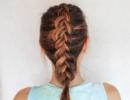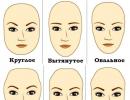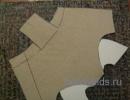Vertical stripes with knitting needles - patent pattern. Openwork tracks with knitting needles - simple openwork patterns Vertical stripes patterns of patterns with knitting needles
10.08.2014
A collection of simple patterns with embossed stripes and knitted stripes
Relief patterns with knitting needles are an alternation when knitting front and back loops, while the fabric turns out to be three-dimensional due to the combination of convex and concave sections, and also quite dense (without gaps). Therefore, such patterns are especially expressive. There are a great variety of relief patterns, they differ in small or large repeat. These patterns are ideal for plain cotton, cotton rayon, silk and linen blends. If the yarn is thick, then the pattern looks especially prominent, and if it is thin, then the result will be an exquisite, noble structure. Relief patterns are quite easy to knit, so they are recommended for beginner knitters, because... help them gain skill and experience. Confident knitters also do not ignore embossed patterns, because they are convenient for combining with openwork and give it a special elegance. To charm relief patterns has not disappeared, you should not iron or steam them, just moisten them and let them dry flat.
We present to your attention large collection simple patterns with relief stripes and stripes (vertical, horizontal, diagonal) for knitting with visual samples, diagrams, descriptions and symbols. Choose and create with pleasure!
Abbreviations:
n. - loop;
persons - facial;
purl - purl;
chrome - edge;
cross. - crossed.
Attention! In the diagrams, the back rows are shown as they look from the front side.
※ Pattern 90 “Tenderness” (for 8 loops and 12 rows)

※ Pattern 89 "Exquisite structure" (for 13 loops and 8 rows)

※ Pattern 88 “Stripe with graphic relief” (for 28 loops and 24 rows)

※ Pattern 87 “Two textured stripes” (for 16 loops and 8 rows)

※ Pattern 86 “Braided stripes” (for 16 loops and 16 rows)

※ Pattern 85 “Original braided stripes” (for 20 loops and 16 rows)

※ Pattern 84 "Strips from relief blocks" (for 10 loops and 14 rows)

※ Pattern 83 “Wavy ribs” (for 2 loops and 12 rows)

※ Pattern 82 “Freeze frame” (for 10 loops and 16 rows)

※ Pattern 81 “Rhombuses and net” (for 42 loops and 16 rows)


※ Pattern 80 "Hearts and chevrons" (for 36 loops and 16 rows)


※ Pattern 79 "Egyptian nights" (for 15 loops and 16 rows)

※ Pattern 78 "Relief stripes" (for 10 loops and 32 rows)

※ Pattern 77 “Jagged stripes” (for 10 stitches and 18 rows)

※ Pattern 76 "Glade" (for 16 loops and 42 rows)

※ Pattern 75 “Sand rain” (for 10 loops and 10 rows)

※ Pattern 74 “False braid” (13 loops and 18 rows)

※ Pattern 73 “Imitation of plaits” (for 19 loops and 16 rows)

※ Pattern 72 “Special stripes” (for 12 loops and 8 rows)

※ Pattern 71 “Symmetrical stripes” (for 18 loops and 8 rows)

※ Pattern 70 “Tree” (for 16 loops and 6 rows)

※ Pattern 69 “Lunar paths” (for 6 loops and 16 rows)

※ Pattern 68 “Relief tracks” (for 18 loops and 20 rows)

※ Pattern 67 “Curly stripes” (for 12 loops and 12 rows)

※ Pattern 66 “Manzherok” (for 11 loops and 10 rows)

※ Pattern 65 "Floral stripes" (for 8 loops and 10 rows)

※ Pattern 64 “Diagonal with curly edge” (for 6 loops and 12 rows)

※ Pattern 63 “Decorative stripe” (for 42 loops and 16 rows)


※ Pattern 62 “Strip with ornament” (for 24 loops and 26 rows)


※ Pattern 61 “Turtle” (for 17 loops and 32 rows)

※ Pattern 60 "Graphic stripes" (for 18 loops and 16 rows)

※ Pattern 59 “Finishing stripes” (for 22 loops and 24 rows)

※ Pattern 58 "Relief diagonal" (for 18 loops and 36 rows)

※ Pattern 57 "Original tracks" (for 14 loops and 20 rows)

※ Pattern 56 “Bracelet” (16 loops and 24 rows)

※ Pattern 55 "Chain" (6 loops and 8 rows)

※ Pattern 54 “Strip with chain” (for 10 loops and 8 rows)

※ Pattern 53 “Stripe with bows” (for 21 loops and 20 rows)

※ Pattern 52 “Scales” (for 8 loops and 32 rows)

※ Pattern 51 “Pastila” (for 10 loops and 30 rows)

※ Pattern 50 “False braid” (for 10 loops and 30 rows)

※ Pattern 49 “Chupa Chups” (for 6 loops and 12 rows)

※ Pattern 48 “Garland” (6 loops and 12 rows)

※ Pattern 47 “Churchkhela” (for 6 loops and 8 rows)

※ Pattern 46 "Original diagonal" (for 8 loops and 16 rows)

※ Pattern 45 “Structural diagonal” (7 loops and 14 rows)

※ Pattern 44 "Diagonal 4x4" (for 8 loops and 16 rows)

※ Pattern 43 "Diagonals 3x3" (for 6 loops and 12 rows)

※ Pattern 42 “Wavy diagonal” (for 4 loops and 12 rows)

※ Pattern 41 “Curly diagonals” (for 18 loops and 18 rows)

※ Pattern 40 "Carved diagonal" (for 12 loops and 16 rows)

※ Pattern 39 “Calm” (for 12 loops and 6 rows)

※ Pattern 38 “Oblique lines” (for 5 loops and 10 rows)

※ Pattern 37 “Spikelet” (for 18 loops and 16 rows)

※ Pattern 36 “Geometry” (for 18 loops and 42 rows)

※ Pattern 35 “Missy-sloping” (for 10 loops and 12 rows)

※ Pattern 34 "Checker stripe" (for 12 loops and 20 rows)

※ Pattern 33 “Parallels” (for 16 loops and 14 rows)

※ Pattern 32 “Stripe of triangles” (for 14 loops and 10 rows)

※ Pattern 31 “Zigzag stripe” (for 9 loops and 6 rows)

※ Pattern 30 “Strip of uneven-high columns” (for 8 loops and 28 rows)

※ Pattern 29 “Wattage” (for 6 loops and 8 rows)

※ Pattern 28 "Linear row" (for 10 loops and 8 rows)

※ Pattern 27 "3x12 columns" (for 8 loops and 16 rows)

※ Pattern 26 "Columns 3x16" (for 8 loops and 20 rows)

※ Pattern 25 "Bamboo" (for 16 loops and 20 rows)

※ Pattern 24 "Scale" (for 14 loops and 24 rows)

※ Pattern 23 "Woven stripes" (14 loops and 32 rows)

※ Pattern 22 “Interlacing stripes” (for 16 loops and 28 rows)

※ Pattern 21 “Lukoshko” (for 16 loops and 20 rows)

※ Pattern 20 “Beads on a string” (for 10 loops and 28 rows)

※ Pattern 19 “Forks” (for 14 loops and 28 rows)

Greetings, dear knitting lovers!
I don’t know about you, but it’s “autumn” outside our window... The sky is overcast with a leaden cloud, from the incessant rain the remaining snow has acquired an unsightly, dirty appearance and is melting... melting...
To cheer myself up and please you, my dears, I am posting openwork patterns knitting needles with patterns. All these patterns have one thing in common - they are knitted in a vertical stripe, which means they will visually slim the figures of even those with curvy figures.
Well, you can apply them fragmentarily, alternating one openwork strip with some other pattern, a strand, for example, or making the product with only one of these patterns - in general, as your imagination dictates. So, welcome!
Openwork knitting patterns in stripes
Knitting pattern “Openwork in stripes” (1)
“Openwork in a stripe” (1) It’s not difficult to make, it’s perfect for knitting items for spring - there aren’t many holes there, so it won’t blow too much.
To learn how to knit a pattern “Openwork in a stripe” (1) for the sample on the knitting needles, we cast on the number of loops divisible by 13, add 1 loop for the symmetry of the pattern and 2 edge loops, for example 26+1+2=29 loops. And then we knit according to the pattern.
Scheme of the pattern “Openwork in stripes” (1)

- plus - edge loop;
- minus - purl loop;
- black square - face loop;
- circle - yarn over;
- even rows -
In the front rows after the edge we knit rapport loops as many times as necessary (between the arrows), at the end of the row - 1 purl and edge loop.
When I started knitting this pattern, I realized that it was familiar to me, only in a slightly different interpretation. Therefore, I decided to immediately post a sample of its almost “double”.
Knitting pattern “Openwork in stripes” (2)
"Double" previous pattern“Openwork in a strip” is performed with fewer loops.

To knit a sample on knitting needles, cast on the number of loops divisible by 9, plus 2 loops for symmetry of the pattern and 2 edge loops: 27+2+2=31.
The pattern can be knitted using the previous pattern, only we knit the front loops in the first row repeat not 8, but 5, and the stripe from the purl stitch is not 3 purl loops, but 2. That's the whole difference.
But if this explanation seems incomprehensible to someone, write, I will draw up a diagram of the pattern.
Knitting pattern “Openwork in stripes” (3)

To knit this openwork pattern in a strip, we cast on the knitting needles a number of loops divisible by 16, add 1 loop for the symmetry of the pattern and 2 edge loops, for example 32+1+2=35. Next we knit exactly according to the pattern below.
Scheme of the pattern “Openwork in stripes” (3)

- plus - edge loop;
- minus - purl loop;
- circle - yarn over;
- black square - face loop;
- triangle with a right angle to the left -We knit 2 loops together with a tilt to the left (we remove the 1st loop as when knitting, we knit the 2nd loop and pull it through the removed loop);
- triangle with right angle to the right - We knit 2 loops together;
- even rows - We knit as the pattern shows, purl the yarn overs.
In the front rows after the edge loop, we repeat the repeat loops as many times as necessary (between the arrows), at the end of the row we knit 1 purl and edge loop.
Knitting pattern “Openwork in stripes” (4)
“Openwork in a stripe” (4) It consists of vertical openwork zigzags and knitting it is also not difficult if you carefully check your actions with the diagram of this pattern below.
To sample the pattern on the knitting needles, you need to cast on a number of loops that is a multiple of 11, adding 2 edge loops, for example 33+2=35, and then knit according to the pattern.
Scheme of the pattern “Openwork in stripes” (4)

- plus - edge loop;
- minus - purl loop;
- circle - yarn over;
- black square - face loop;
- triangle with a right angle to the left -
- triangle with right angle to the right - We knit 2 loops together;
- even rows -
In the front rows between the edge rows we repeat only the repeat loops that are located between the arrows.
Knitting pattern “Openwork in stripes” (5)
This unusual pattern in a stripe, which is best used as an insert on the front surface, is also not difficult to make.
To knit a sample pattern, cast on 23 loops plus 2 edge stitches, and then knit according to the pattern pattern.
Scheme of the pattern “Openwork in stripes” (5)

- black square - face loop;
- minus - purl loop;
- circle - yarn over;
- triangle with a right angle to the left -We knit 2 loops together with a tilt to the left;
- triangle with right angle to the right - We knit 2 loops together;
- even rows - We knit as the pattern shows, yarn overs - with purl loops.
Knitting pattern “Openwork in stripes” (6)
This beautiful pattern in a strip of leaves laid out one on top of the other, reminded me of another. What’s interesting is that this pattern is much easier to knit than that, although at first glance it seems that, on the contrary, it is more difficult.

To knit a sample pattern, cast on a multiple of 24 loops on the knitting needles, add 2 loops for symmetry of the pattern and 2 edge loops.
Scheme of the pattern “Openwork in stripes” (6)

- white cell - face loop;
- in purl rows: above the hinges garter stitch knit stitches over purls and yarn overs (10 loops)- purl;
- in the front rows: repeat repeat loops (24 loops), at the end of the row - 2 garter stitch loops and an edge stitch.
That's all for today! I hope you liked these openwork knitting patterns with patterns and you use them for knitting spring or summer new clothes.
And may there be more sunny days in your life!
And this is a musical gift: a song "Crossroads of Seven Roads" performed by the band “Time Machine”, which I adored in my youth.
...Oh, the residents of Ukraine are now at such a “crossroads” that you wouldn’t wish it on anyone...
With love, Elena Zhabina and mine
Let's take a little rest from the hook and knit with knitting needles... Consider the patent pattern. You and I already know how to knit, you can knit vertical ones in the same way, but today we’re talking about a different method... It’s more complicated, but nevertheless, I like it
Patent knitting pattern
We cast on 20 loops on the knitting needles in any way and knit one row. And now:!: ATTENTION :!:
- remove the first loop,
- we knit the second one,
- and we REMOVE the third WITHOUT KNITTING, with the working thread “at work”
How to remove a knit stitch without knitting

We insert the needle into the loop on the left needle, as if we were going to knit a knit stitch.
but we don’t knit it, we just throw it on right knitting needle. (the thread remains behind the fabric)
- fourth loop - facial
- The fifth, like the 3rd, is removed without knitting, so we continue until the end of the row... We knit one knit row, we simply remove one, with the working thread behind the work - this will be the Knit row.
We finished the row and turned the knitting.
PURL row  Consider what happened...
Consider what happened...
You will see that where you did not knit the loops, broaches formed, so in this row we will not knit these loops, we will also remove them, only we will hold the working thread in front of the work (in front of ourselves), and remove the loop as as if we were going to knit the purl one... (i.e. we insert the knitting needle from top to bottom) we also knitted 1 through one purl loop, 1 loop removed (thread before work)
How to purl a stitch without knitting

We insert the needle into the loop on the left needle, as if we were going to knit a purl stitch.
but we don’t knit it, we just throw it onto the right knitting needle. (the thread remains in front of the fabric)
We knit one purlwise, we simply remove one, and the working thread before work will be the PURLING row.
This way you only get broaches from the wrong side. But there are no broaches on the front.  And now the fun begins)))
And now the fun begins)))
We will introduce a thread of a different color.
I’ll admit right away that I don’t know how to make edge loops here, I do this this way and that... we will knit them...
So, we take a thread of a different color and start knitting the next row with it, and we knit only those loops that were previously removed without knitting, therefore, we remove those that were knitted)))
In the front rows we knit the front loops and remove them like front ones (working thread behind the work)
In the purl rows we knit purl loops and remove them as purl stitches (working thread before work)
Front row:  Purl row:
Purl row:  We knit two rows with each color (knit + purl, see the description of their knitting above in the text). In fact, everything is easy... you just need to understand... and everything will work out
We knit two rows with each color (knit + purl, see the description of their knitting above in the text). In fact, everything is easy... you just need to understand... and everything will work out
The result is vertical stripes.
Patent stripe pattern - front and back

The knitting is dense and thick. It's kind of double. We will call this type of pattern “pressed pattern” or patent pattern
P.S. Advice: good))) - take thin knitting needles and yarn and do not tighten the thread when knitting, otherwise you will suffer)))







